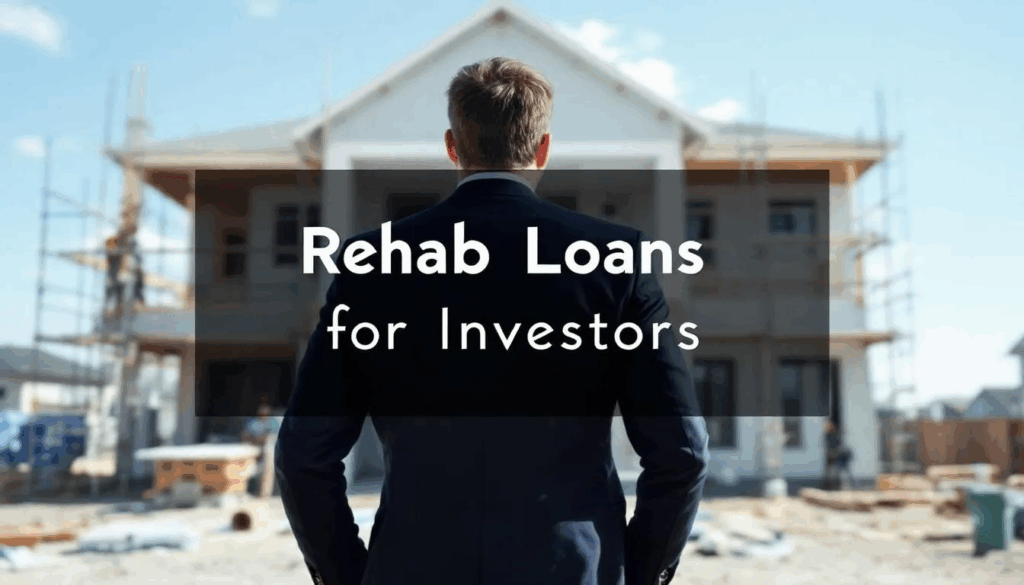What is a Rehab Loan?
A rehab loan is a financing product for investors to renovate properties. It’s also called a renovation loan. Instead of getting a mortgage and a separate home renovation loan, rehab loans fund both in a single financing product.
Rehab loans allow investors to borrow money specifically for property improvements, making it easier to finance renovations without relying solely on personal funds.
These loans offer quick access to funds, allowing investors to cover expenses such as mortgage payments during renovations. Investors can secure these loans within a few days, expediting the renovation process.
Real estate investors can use these loans to renovate rental properties or flip houses for profit. They often increase the property’s value, increasing investors’ returns.
Real Estate Investment Strategies with Rehab Loans
Rehab loans open up a range of powerful investment strategies for real estate investors. One common approach is to use a rehab loan to purchase and renovate a fixer-upper, then sell the property for a profit once the improvements are complete. This “fix-and-flip” strategy enables investors to leverage borrowed funds to enhance the property’s value and generate a return on investment in a relatively short period.
Another effective strategy is to use rehab loans to finance the renovation of rental properties, such as single-family homes or multi-unit buildings. By upgrading and improving these properties, investors can boost rental income and property value, enhancing long-term cash flow and building equity.
For those looking to scale their real estate portfolio, rehab loans can also be used to finance the purchase and renovation of multiple properties simultaneously. This enables investors to diversify their holdings and capitalize on emerging market opportunities.
By incorporating rehab loans into their overall investment strategy, real estate investors can access the funds needed to acquire, renovate, and profit from a wide variety of properties—turning vision and hard work into tangible financial success.
How do Rehab Loans for Investors work?
Understanding the financing process is crucial for investors to secure and utilize a rehab loan successfully. Here is the typical process for a real estate investor using a rehab loan program:
- Find a lender that meets your qualifications (i.e., minimum requirements for credit score, income, etc.).
- Acquire homeowner’s insurance.
- Get a contractor and detailed, written estimates on renovations.
- Send estimates to the lender for approval.
- If approved, the funds will be deposited into an escrow account to cover renovation costs.
- Complete all necessary repairs and obtain any required permits and inspections.
- The funds get released to pay the contractor upon completion.
- Pay your rehab loan off like a regular mortgage.
What types of Rehab Loans are available for Investors?
There are several options for builder & construction loans.
Investment Property Line of Credit
An investment property line of credit can be a valuable resource for real estate investors seeking to fund their projects. It allows investors to borrow against the equity in their investment properties, providing them with access to funds that can be used for renovations, repairs, or even the purchase of additional properties.
It’s similar to a Home Equity Line of Credit (HELOC), which homeowners often use for renovations by leveraging the equity in their property. Home equity lines are a common way for homeowners and investors to access ongoing funds for renovations by borrowing against the equity in their property.
One of the key benefits of an investment property line of credit is that it provides flexibility, allowing investors to draw on the funds as needed and only pay interest on the amount borrowed. This can be especially useful for investors who may need quick access to capital for time-sensitive opportunities in the real estate market.
Using an investment property line of credit can help investors leverage their existing properties to grow their portfolios and increase their overall returns. It’s essential for investors to carefully consider the terms and conditions of the line of credit, as well as their own financial situation and investment goals, before utilizing this financial tool.
FHA 203(k) Loans
Permanent Rehab Federal Housing Administration (FHA) 203(k) Loans are a popular option for individuals looking to purchase a home that needs significant repairs or renovations. This type of loan is also known as a renovation mortgage loan, as it combines the costs of buying and renovating a property into a single mortgage. These loans enable borrowers to finance both the home’s purchase price and renovation costs in a single loan, making it easier to fund the entire project.
FHA 203(k) loans are available for both primary residences and investment properties, offering flexibility for investors who want to rehab properties for rental or resale purposes. Primary residents can use these loans to pay off an existing mortgage, make renovations, or refinance the property.
A primary benefit of FHA 203(k) loans is that they offer relatively low down payment requirements, making them accessible to a wide range of borrowers. Additionally, these loans typically have competitive interest rates compared to other home improvement loans, helping borrowers save money over the life of the loan.
The FHA 203(k) program also has specific guidelines for the types of renovations that can be financed, ensuring that the property meets particular standards once the work is completed. FHA 203(k) loans currently require a credit score of 500 for a 10% down payment or above, and 580 for a 3.5% down payment.
Fannie Mae & Freddie Mac Loan Options
Fannie Mae and Freddie Mac both offer rehab loan programs designed to combine the costs of purchasing or refinancing a home with the funds needed for renovations. These programs provide a conventional alternative to government-backed options, such as FHA 203(k), making them attractive to both investors and homeowners.
Fannie Mae’s HomeStyle Renovation Mortgage allows borrowers to finance renovations as part of a conventional mortgage. Eligible improvements range from necessary repairs to luxury upgrades, giving borrowers flexibility in tailoring the loan to their property goals. Fannie Mae HomeStyle Renovation Mortgages require a minimum credit score of 620 or higher.
Freddie Mac CHOICE Renovation loans can be used to finance primary residences, second homes, and one-unit investment properties. These loans also support resiliency improvements, such as flood or disaster-prevention upgrades. Additionally, Freddie Mac CHOICERenovation loans can be used to finance manufactured homes, making them a flexible option for a variety of property types. Freddie Mac CHOICERenovation loans require a minimum credit score of 660 or higher.
Hard Money Rehab Loan
Hard money business loans are a short-term, asset-based option commonly provided by other private investors or companies to investors. Real estate investors typically use hard money loans to purchase and renovate properties. These loans are secured by the property itself rather than the borrower’s creditworthiness. The property’s equity is a key factor in determining the loan amount and serves as collateral for the loan. Hard money lenders will look at the property’s after-repair value to determine loan amounts.
The lenders are often private individuals or companies willing to take on higher risk in exchange for potentially higher returns. The terms of hard money loans are typically shorter than those of traditional mortgages, often accompanied by higher interest rates and fees.
This type of financing can be beneficial for investors who require rapid access to capital to fund their rehabilitation projects. However, it is essential to carefully consider the terms and costs associated with hard money loans before moving forward with this type of financing.
Short-Term Bridge Loans
Short-term bridge loans, also known as fix-and-flip loans, are a popular option for property investors seeking to renovate a property quickly. These are a form of short-term loans designed to provide quick funding for renovation projects. These loans provide investors with the necessary funds to purchase a property, complete renovations, and then sell it for a profit within a short period.
One key benefit of short-term bridge loans is their flexibility. These loans are typically easier to qualify for than traditional bank loans, making them ideal for investors who may not meet strict lending criteria. Additionally, bridge loans can be approved and funded quickly, enabling investors to proceed with their renovation projects without delay.
Another advantage of short-term bridge loans is that they are specifically designed for property investors. Lenders understand the unique needs of investors looking to renovate and sell properties quickly, so they offer loan terms tailored to these needs. This can include flexible repayment schedules, interest-only payments, and higher loan-to-value ratios.
How do I Choose the Best Rehab Loan for my Investment?
Selecting the best loan for your investment is a crucial step for real estate investors aiming to maximize returns and minimize risk. Start by evaluating the purchase price of your target property and estimating the total renovation costs. With these figures in hand, compare various loan options—such as the Federal Housing Administration’s 203(k) loan, hard money loans, and other renovation loan programs—to determine which best aligns with your investment goals.
When comparing rehab loans, pay close attention to the loan amount offered, interest rates, repayment terms, and payment requirements. For example, hard money loans may provide faster access to funds but often come with higher interest rates and shorter repayment periods. In contrast, a 203(k) loan might offer lower rates but require more documentation and a longer approval process.
It’s also essential to consider the value of the property both before and after renovation. Make sure the loan amount is sufficient to cover both the purchase and renovation costs, and that the projected after-repair value supports your investment strategy. By carefully weighing these factors and reviewing the terms of each rehab loan, investors can select the financing solution that best suits their needs, thereby helping to ensure a successful and profitable real estate investment.
What can Investors do with a Rehab Loan?
Depending on the type of loan you obtain, property investors can use the funds to make various repairs, home improvements, or renovations, which help prepare the property for sale or rent. Here are some examples of the upgrades you make:
- Remodeling kitchens and bathrooms
- Replacing major appliances (fridges, dishwashers, etc.)
- Repairing or upgrading heating and cooling systems
- Updating materials for greater energy efficiency
- Structural modifications
- Septic system improvements and connecting to public water/sewer
- Replacing roofing, gutters, drainage, floors, or carpet
- ADA modifications
- Large landscaping projects
Making these improvements and structural modifications can help attract buyers and increase the property’s marketability.
What are the qualifications for a Rehab Loan?
The qualifications largely depend on the type of loan. Most mortgage lenders look at your income and credit score, but others may not. For example, a hard money lender might not even look at your credit score, but you’ll need a significant down payment and real property to pledge as collateral.
Qualifications for a FHA 203(k) loan are:
- Minimum credit score of 500 & 10% down payment, or 580 and 3.5% down payment
- Proof of steady income and employment
- The borrower must work with an approved FHA 203(k) lender
- Property must meet the FHA minimum property standards
Most other rehab loans require a good to excellent credit score or a strong portfolio of investment properties to use as collateral. A successful track record of renovating and selling or renting properties can also help with approval.
The best way to determine eligibility is to contact lenders directly and discuss the qualifications. You may need to shop around before finding a lender that works for you.
How do I apply for a Rehab Loan?
Follow these steps to apply for and use a rehab loan.
- Research lenders: Start by researching lenders who offer rehab loans. Look for reputable financial institutions or specialized lenders with experience in providing these types of loans.
- Gather necessary documents: Before applying for a rehab loan, gather all the essential documents, such as proof of income, credit history, employment information, and details about the property you plan to renovate.
- Determine loan amount: Calculate the estimated cost of your rehabilitation project to determine how much you need to borrow. Make sure to factor in the renovation costs and any fees associated with the loan.
- Submit an application: Once you have selected a lender and gathered all the required documents, submit your loan application. Be prepared to provide detailed information about your project, financial situation, and the property you plan to renovate.
- Wait for approval: After submitting your application, the lender will review your information, determine if you qualify, and start underwriting. This process may take some time, so be patient while waiting for a decision.
- Close on the loan: After receiving approval, you can close on the loan. This involves signing the necessary paperwork and paying any closing costs associated with the loan. Typically, the funds are deposited into an escrow account to cover the costs of the renovations.
- Start your renovation project: Once the loan is closed, you can start your renovation project. Stick to your budget and timeline to ensure a successful rehabilitation project.
What are the benefits and drawbacks of a Rehab Loan?
Investors benefit from rehab loans by quickly accessing the funds needed for renovations. This advantage enables them to begin working on their investment properties without delay. With traditional loans, the approval process can be lengthy, causing investors to miss out on valuable time.
One drawback of rehab loans is that they often come with higher interest rates than conventional loans. While these loans provide the necessary capital for renovations, investors must consider the long-term financial implications of paying back a loan with increased interest. However, some rehab loan options, such as specific government-backed programs, may offer lower interest rates compared to private loans, helping reduce overall borrowing costs.
Rehab Loans Pros & Cons
Pros:
- Allows investors to purchase properties that need renovation at a lower cost.
- Can increase the property’s value, leading to higher potential profits.
- Provides financing for purchasing and renovating a property in one loan.
- Offers flexibility in terms of property types that can be financed.
Cons:
- Higher interest rates compared to traditional mortgages.
- Requires a higher level of documentation & a complex approval process.
- Limited availability from traditional lenders.
- Risk of unforeseen renovation costs exceeding the original budget.
- Some rehab loans are not designed for long-term financing.
Frequently Asked Questions
Here are the most common questions about rehab loans for investors.
How much can I borrow with a Rehab Loan?
The amount you can borrow with certain rehab loans often depends on the property’s current value. Lenders typically calculate the available equity by subtracting the outstanding mortgage balance from the property’s current value. This equity determines how much you may be able to borrow.
How much do Rehab Loans cost?
Rehab loans can vary in cost for investors, depending on several factors, such as the lender, the loan amount, the scope of the renovation project, and the investor’s financial profile. Generally, rehab loans may have higher interest rates and fees than conventional mortgage loans due to the increased risk associated with financing a property that requires significant repairs or improvements. The property’s condition and value can also influence the interest rates and fees associated with a rehab loan, as lenders often consider the property’s current or after-repair value when determining loan terms.
Investors should expect to pay origination fees, closing costs, and potentially higher interest rates on rehab loans. It’s essential for investors to carefully review and compare loan terms from different lenders to ensure they are getting the best deal possible for their rehab project. Additionally, investors should factor in the costs of the renovations themselves when budgeting for a rehab loan to ensure they have enough funds to complete the project successfully.
Most commonly, these loans include interest rates ranging from 7% to 18%, origination fees of around 1% to 3% of the loan amount, closing costs such as appraisals and inspections, as well as potential prepayment penalties or late fees.
How long does it take to get a Rehab Loan?
The time it takes to close on a rehab loan largely depends on the type of loan and lender. Hard money loans and fix-and-flip loans typically have much faster funding times.
If you are purchasing a new property that requires renovations, it’s essential to factor in the loan closing timeline to avoid delays in starting your project.
You can potentially close and fund a hard money loan in just a few business days. Short-term bridge loans typically have a funding time of 3 to 10 business days.
Investment property lines of credit can also be closed quickly, potentially within a few business days. However, that largely depends on the lender and your qualifications and documentation.
FHA 203(k) loans typically have a longer closing time, often exceeding 60 days. Ensure you determine closing times and factor them into your renovation timeline.
Can I use Business Loans to Rehab an Investment Property?
Using a business loan for an investment property rehab might be possible, but there are challenges. Typically, you need a registered business that specializes in flipping or renovating homes and has been in operation for several years. That means you’ll likely need to be established as a legal business entity (such as a sole proprietor, general partnership, LLC, or corporation) with a business credit history.
You might be interested in one of the following small business loans:
- Bad credit business loan
- Business line of credit
- Business loans for women
- Business term loans
- Equipment financing
- Accounts receivable factoring
- Merchant cash advance
- Revenue based business loans
- SBA loans
- Working capital loans
Rehab Loans for Investors – Final Thoughts
Rehab loans provide real estate investors with a valuable tool for financing property renovations and enhancing potential profits. These loans offer flexibility, access to funds, and the ability to leverage investments effectively.
By understanding the benefits and risks associated with rehab loans, investors can make informed decisions to maximize their returns on investment. Ultimately, rehab loans can be a strategic financial tool for investors looking to grow their real estate portfolios and achieve success in the market.
Contact us if you have more questions about rehab loans or to apply for a small business loan. Our alternative funding experts can help you find the best financing options for your business or commercial real estate needs.












